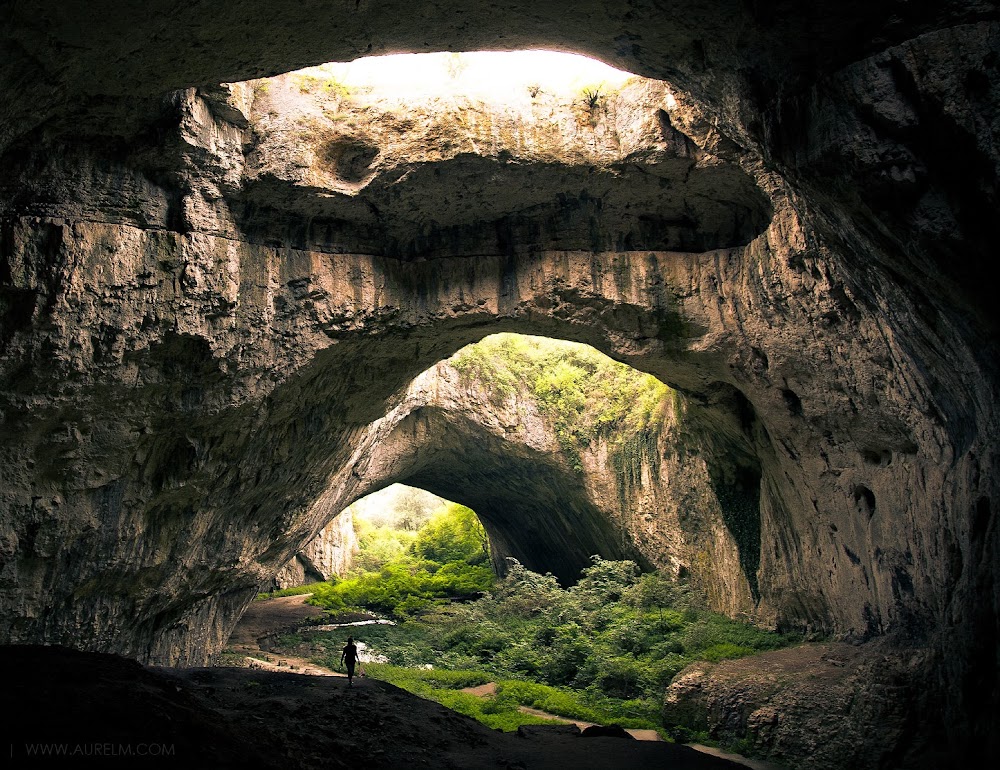
Interestingly, the design is based on actual photography from Devetashka Cave in Bulgaria:

 Shane Powers (USA) & Linjie Wang (China) have created a design of an artificial underground oasis in a Martian lava tube for Marstopia international design contest held by Eleven Magazine. Their design named "Below Freezing" won the "honourable mention" award in the contest. Its main feature, besides utilizing natural lava tubes, is a vertical transportation system (surrounded by 3D-printed ice walls) to Mars's surface. Martian lava tubes could become very handy in creating large, radiation-protected spaces for future human colonists on Mars.
Shane Powers (USA) & Linjie Wang (China) have created a design of an artificial underground oasis in a Martian lava tube for Marstopia international design contest held by Eleven Magazine. Their design named "Below Freezing" won the "honourable mention" award in the contest. Its main feature, besides utilizing natural lava tubes, is a vertical transportation system (surrounded by 3D-printed ice walls) to Mars's surface. Martian lava tubes could become very handy in creating large, radiation-protected spaces for future human colonists on Mars.

Paul Williams wrote:
ReplyDeleteThis looks like an artist's concept, and we need to ask the engineering questions that I'm not qualified to answer, but will make an attempt anyway.
To maintain atmospheric pressure in such a large enclosed volume, it will likely be necessary to segment a lava tube, possibly taking advantage of natural roof collapses as "plugs". Access could be by airlocks set into these plugs, communicating with an unpressurized section of the lava tube, and thence to the outside world, maybe though a skylight. Electric cables from a surface solar farm could follow the same path.
This still requires sealing the whole interior surface which will presumably be porous to some extent. At all latitudes, the ground temperature seems to be below freezng, all the way down to 4 to 8 km.
https://www.nap.edu/read/11381/chapter/6#45
This means that releasing water in a lava tube should lead to its evaporation, then icing of the inner surface. That should make a good impervious layer, allowing pressure to build up inside. If we use LED lighting to start life processes, the warmth should gradually warm the surface ice layer that would melt in places. Water vapor should then penetrate due to cracks and porosity, forming a new ice layer inside the rock.
It might be necessary to find a sweet spot where a lava tube is deep enough for the suggested ice layer to form a safe distance below the Martian surface.
A lava tube oasis could finish up as a long lake with vegetation between its shore and the tube wall. A water cycle could establish itself by evaporation from the lake surface, condensation on the roof and within the walls, then running down back into the lake.
Human habitation could be anything from troglodite dwellings built into the walls to wooden houses around the lake. A major question would be sewage disposal, presumably with septic tanks feeding into the lake, leaving aquatic life to complete the anaerobic treatment. Water supply would be from the vapor condensation process mentioned earlier.
This is clearly not a tropical oasis, but more of a Nordic style, much as represented in the illustrations. IMO, its a welcome and refreshing alternative to Martian city living as keeps getting represented in colonization projects!
Who wants to take the idea further?
I'm Mars Society china director how can i contact Linjie Wang (China)
ReplyDeleteWe don't have her contacts. Maybe you can ask Eleven Magazine, the host of the Marstopia competition: https://eleven-magazine.com/contact/
DeleteLinjie and I designed this concept together are free for any further questions. You can reach us at sppowers@vt.edu and linjie@vt.edu
Delete